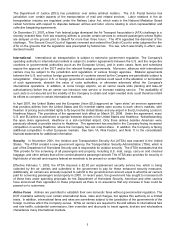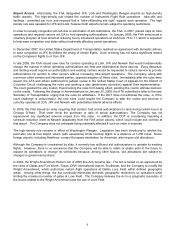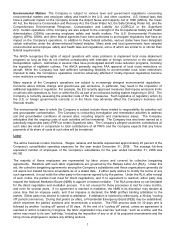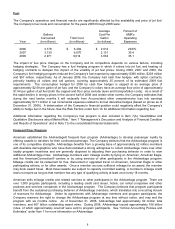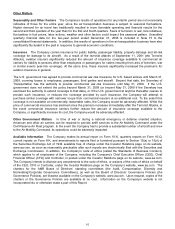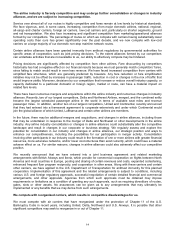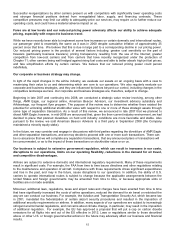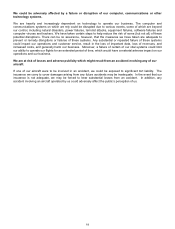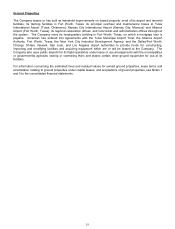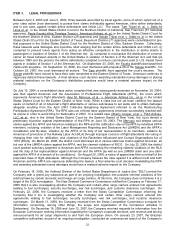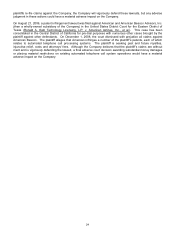American Airlines 2008 Annual Report Download - page 18
Download and view the complete annual report
Please find page 18 of the 2008 American Airlines annual report below. You can navigate through the pages in the report by either clicking on the pages listed below, or by using the keyword search tool below to find specific information within the annual report.15
Successful reorganizations by other carriers present us with competitors with significantly lower operating costs
and stronger financial positions derived from renegotiated labor, supply, and financing contracts. These
competitive pressures may limit our ability to adequately price our services, may require us to further reduce our
operating costs, and could have a material adverse impact on us.
Fares are at low levels and our reduced pricing power adversely affects our ability to achieve adequate
pricing, especially with respect to business travel.
While we have recently been able to implement some fare increases on certain domestic and international routes,
our passenger yield is essentially the same as it was in 2000 despite cumulative inflation of approximately 25
percent since that time. We believe that this is due in large part to a corresponding decline in our pricing power.
Our reduced pricing power is the product of several factors including: greater cost sensitivity on the part of
travelers (particularly business travelers); pricing transparency resulting from the use of the Internet; greater
competition from low-cost carriers and from carriers that have recently reorganized under the protection of
Chapter 11; other carriers being well hedged against rising fuel costs and able to better absorb high jet fuel prices;
and fare simplification efforts by certain carriers. We believe that our reduced pricing power could persist
indefinitely.
Our corporate or business strategy may change.
In light of the rapid changes in the airline industry, we evaluate our assets on an ongoing basis with a view to
maximizing their value to us and determining which are core to our operations. We also regularly evaluate our
corporate and business strategies, and they are influenced by factors beyond our control, including changes in the
competitive landscape we face. Our corporate and business strategies are, therefore, subject to change.
Beginning in late 2007 and continuing into 2008, we conducted a strategic value review involving, among other
things, AMR Eagle, our regional airline, American Beacon Advisors, our investment advisory subsidiary and
AAdvantage, our frequent flyer program. The purpose of the review was to determine whether there existed the
potential for unlocking additional stockholder value with respect to one or more of these strategic assets through
some type of separation transaction. As a result of this review, we announced in late 2007 that we planned to
divest AMR Eagle; however, in mid-2008 we announced that, given the then-current industry environment, we had
decided to place that planned divestiture on hold until industry conditions are more favorable and stable. Also
pursuant to the review, we sold American Beacon Advisors to a third party in September 2008 (the Company
maintained a minority equity stake).
In the future, we may consider and engage in discussions with third parties regarding the divestiture of AMR Eagle
and other separation transactions, and we may decide to proceed with one or more such transactions. There can
be no assurance that we will complete any separation transactions, that any announced plans or transactions will
be consummated, or as to the impact of these transactions on stockholder value or on us.
Our business is subject to extensive government regulation, which can result in increases in our costs,
disruptions to our operations, limits on our operating flexibility, reductions in the demand for air travel,
and competitive disadvantages.
Airlines are subject to extensive domestic and international regulatory requirements. Many of these requirements
result in significant costs. For example, the FAA from time to time issues directives and other regulations relating
to the maintenance and operation of aircraft. Compliance with those requirements drives significant expenditures
and has in the past, and may in the future, cause disruptions to our operations. In addition, the ability of U.S.
carriers to operate international routes is subject to change because the applicable arrangements between the
United States and foreign governments may be amended from time to time, or because appropriate slots or
facilities are not made available.
Moreover, additional laws, regulations, taxes and airport rates and charges have been enacted from time to time
that have significantly increased the costs of airline operations, reduced the demand for air travel or restricted the
way we can conduct our business. For example, the Aviation and Transportation Security Act, which became law
in 2001, mandated the federalization of certain airport security procedures and resulted in the imposition of
additional security requirements on airlines. In addition, many aspects of our operations are subject to increasingly
stringent environmental regulations, and concerns about climate change, in particular, may result in the imposition
of additional regulation. For example, the EU has approved a proposal that will put a cap on carbon dioxide
emissions for all flights into and out of the EU effective in 2012. Laws or regulations similar to those described
above or other U.S. or foreign governmental actions in the future may adversely affect our business and financial
results.


